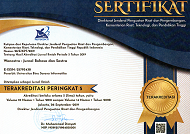Guilt and Madness in Edgar Alan Poe's "The Tell-Tale Heart”: Psychoanalysis Study
Abstract
Full Text:
PDFReferences
Allen, M. G. (2023). The Tell-Tale Heart: Interoceptive Precision and Ecological Fear Experiences. 30. https://doi.org/https://doi.org/10.31234/osf.io/ngamx
Alsahafi, M. (2019). A Narrative Discourse Analysis of Poe’s Short Story “The Tell-Tale Heart”: Implications for Language Teaching. English Language Teaching, 13(1), 1. https://doi.org/10.5539/elt.v13n1p1
Baumeister, R. F., Stillwell, A. M., & Heatherton, T. F. (1994). Guilt: An interpersonal approach. Psychological Bulletin, 115(2), 243–267. https://doi.org/10.1037/0033-2909.115.2.243
Bennett, A., & Royle, N. (2004). An introduction to literature, criticism and theory. An Introduction to Literature, Criticism and Theory, 1–432. https://doi.org/10.4324/9781315652450
Bocock, R. (1983). Key Sociologists: Sigmund Freud. TAVISTOCK PUBLICATION.
Ethridge, D. E. (2004). Research Methodology in Applied Economics (2nd ed.). Blackwell Publishing.
Fox, William. Bayat, M. S. (2008). A Guide to Managing Research. Juta and Company Ltd.
Freud, Sigmuend. (1931). THE INTERPRETATION OF DREAMS. 1–328.
Freud, Sigmund. (1923). Freud , S . ( 1923 ). The Ego and the Id . The Standard Edition of the Complete Psychological Works of Sigmund Freud. XIX(1923–1925), 1–66.
Freud, Sigmund. (1989). The Ego And The Id (1923). TACD Journal, 17(1), 5–22. https://doi.org/10.1080/1046171X.1989.12034344
Groot, J. L.-D. (1962). Ego Ideal and Superego. The Psychoanalytic Study of the Child, 17(1), 94–106. https://doi.org/10.1080/00797308.1962.11822840
Higgins, E. T., Bond, R. N., Klein, R., & Strauman, T. (1986). Self-discrepancies and emotional vulnerability: How magnitude, accessibility, and type of discrepancy influence affect. Journal of Personality and Social Psychology, 51(1), 5–15. https://doi.org/10.1037/0022-3514.51.1.5
Hossain, M. M. (2017). Psychoanalytic theory used in English literature: A descriptive study. Global Journal of Human-Social Science: Linguistics & Education, 17(1), 41–46.
Kaur, U., & Puri, P. (2023). Murder of the Eye (I): Disruption of Circumscription in “The Tell-Tale Heart.” ANQ: A Quarterly Journal of Short Articles, Notes and Reviews, 1–10. https://doi.org/10.1080/0895769X.2023.2199060
Lapsley, D. K., & Stey, P. C. (2012). Id, Ego, and Superego. In Encyclopedia of Human Behavior (pp. 393–399). Elsevier. https://doi.org/10.1016/B978-0-12-375000-6.00199-3
Mahsun. (2005). Metode penelitian bahasa: tahap strategi, metode, dan tekniknya. PT Rajagrafindo Persada.
Nurjanah, H. (2022). Death Drives: Jacques Lacan’s Thoughts Manifestation In Edgar Allan Poe’s Writings. FABulous Press.
Parkin Gounelas, R. (2001). LITERATURE AND PSYCHOANALYSIS (1st ed.). PALGRAVE.
Ramis, H., Tolan, P., & Lonergan, K. (2001). Freud and psychoanalysis. In Communication Studies: The Essential Resource (1st ed.). POCKET ESSENTIAL. https://doi.org/10.4324/9781315662466-9
Seligman, M. E. P., & Csikszentmihalyi, M. (2000). Positive psychology: An introduction. American Psychologist, 55(1), 5–14. https://doi.org/10.1037/0003-066X.55.1.5
Shamaila Amir. (2017). Analysis of the Short Story “ The Tell - Tale Heart ” by Edgar Allan Poe. The Creative Launcher, 2(3), 596–606.
Sibi, K. J. (2020). Sigmund Freud and Psychoanalytic Theory 16. Sigmund Freud and Psychoanalytic Theory. Langlit Journal, May, 16–79. https://www.researchgate.net/publication/342610778
Siegfried, W. (2014). The Formation and Structure of the Human Psyche: Id, Ego, and Superego - The Dynamic (Libidinal) and Static Unconsciousness, Sublimination, and the Social Dimension of Identity Formation. Undergraduate Philosophy Journal, 62(2), 1–3. http://biostor.org/reference/7013
Sigmund Freud. (1920). Beyond The Pleasure Principle Group Psychology.
Sinding Jensen, J. (2016). Myths and Mythologies. Routledge. https://doi.org/10.4324/9781315475776
Stinson, D. A., Hoplock, L. B., & Huang, E. T. (2022). The tell-tale heart: Self-esteem, arousal, and relationship
initiation. Self and Identity, 21(7), 775–791. https://doi.org/10.1080/15298868.2021.1992494
Szasz, T. (2017). My Madness Saved Me. Routledge. https://doi.org/10.4324/9781315124971
Tato, C. M., & Cua, D. J. (2008). Reconciling id, ego, and superego within interleukin‐23. Immunological
Reviews, 226(1), 103–111. https://doi.org/10.1111/j.1600-065X.2008.00715.x
Thurschwell, P. (2000). Pamela Thurschwell.
Zhang, S. (2020). Psychoanalysis: The Influence of Freud’s Theory in Personality Psychology. Proceedings of the International Conference on Mental Health and Humanities Education (ICMHHE 2020), 433(Icmhhe), 229–232. https://doi.org/10.2991/assehr.k.200425.051
DOI: https://doi.org/10.31294/wanastra.v16i1.20249
Copyright (c) 2024 Rista Nur Kholifah, Aulia Sahda Rahima, Nurhabibah Qurrotul 'Aini, Hidayatul Nurjanah

This work is licensed under a Creative Commons Attribution-ShareAlike 4.0 International License.
Index by:
Published by Department of Research and Community Service (LPPM) Universitas Bina Sarana Informatika by supported Relawan Jurnal Indonesia
Jl. Kramat Raya No.98, Kwitang, Kec. Senen, Jakarta Pusat, DKI Jakarta 10450

This work is licensed under a Creative Commons Attribution-ShareAlike 4.0 International License






